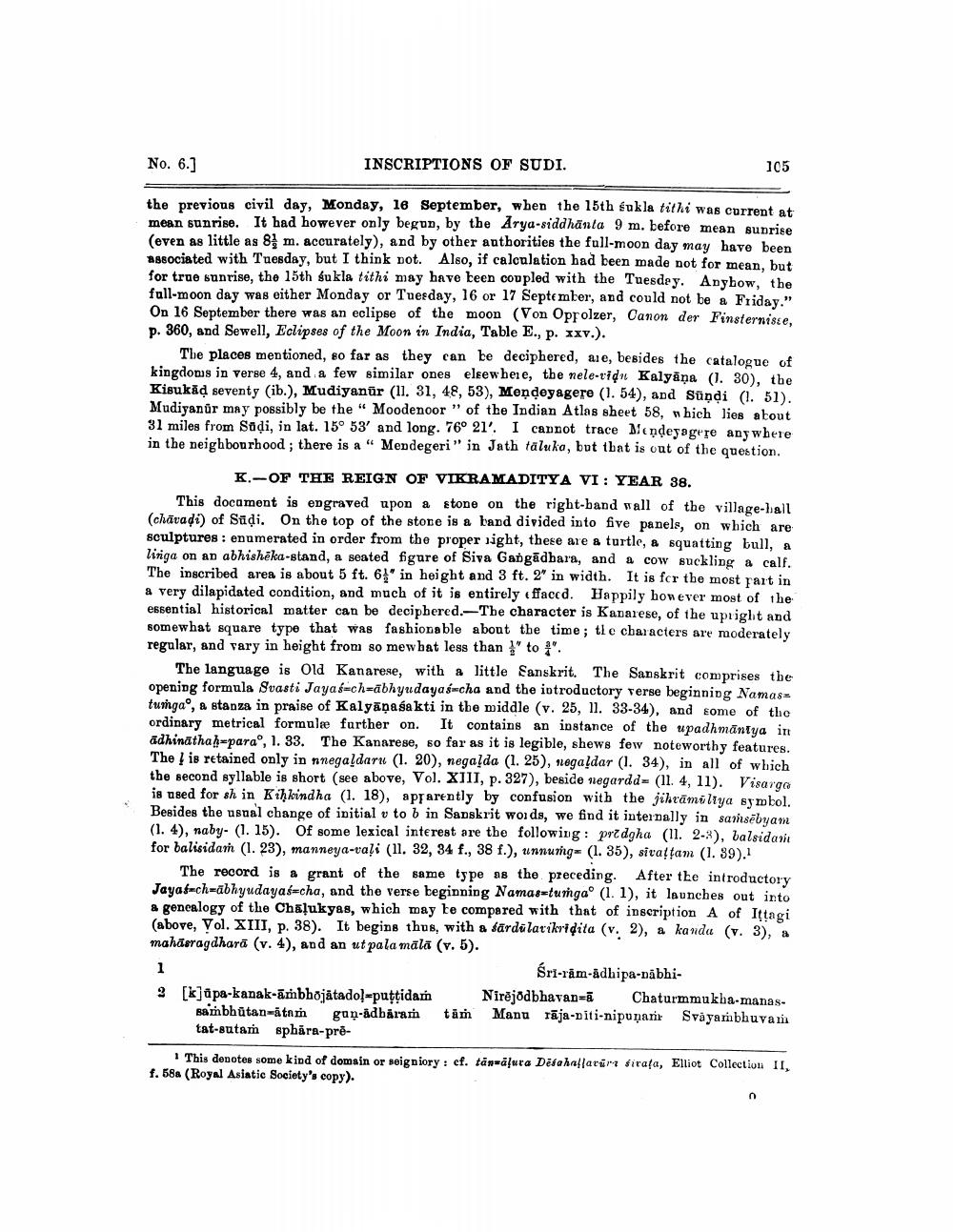________________
No. 6.]
INSCRIPTIONS OF SUDI.
105
the previons civil day, Monday, 16 September, when the 15th bukla tithi was corrent at mean sunrise. It had however only begun, by the Arya-siddhānta 9 m. before mean sunrise (even as little as 81 m. accurately), and by other authorities the full-moon day may have been associated with Tuesday, but I think not. Also, if calculation had been made pot for mean, but for true sunrise, the 15th sukla tithi may have been coupled with the Tuesdey. Anyhow, the full-moon day was either Monday or Tuesday, 16 or 17 September, and could not be a Friday." On 16 September there was an eclipse of the moon (Von Oppolzer, Canon der Finsternisce, p. 360, and Sewell, Eclipses of the Moon in India, Table E., p. xxv.).
The places mentioned, so far as they can be deciphered, aie, besides the catalogue of kingdoms in verse 4, and a few similar ones elsewhere, the nele-vidn Kalyana (1. 30), the Kisukad seventy (ib.), Mudiyanür (11. 31, 48, 53), Mendoyagere (1. 54), and Sündi (1. 51). Mudiyanür may possibly be the "Moodenoor" of the Indian Atlas sheet 58, which lies about 31 miles from Sodi, in lat. 15° 53' and long. 76° 21'. I cannot trace Mundeyagere anywhere in the neighbourhood; there is a " Mendegeri" in Jath täluka, but that is out of the question.
K.-OF THE REIGN OF VIKRAMADITYA VI : YEAR 38. This document is engraved upon a stone on the right-band wall of the village-ball (chävadi) of Sūdi. On the top of the store is a band divided into five panels, on which are sculptures : enumerated in order from the proper sight, these are a turtle, a squatting bull, a liriga on an abhishēka-stand, a seated figure of Siva Gangādbara, and a cow suckling a calf. The inscribed area is about 5 ft. 6' in height and 3 ft. 2" in width. It is for the most part in a very dilapidated condition, and much of it is entirely effaced. Happily however most of the essential historical matter can be deciphered.-The character is Kanarese, of the upright and somewhat square type that was fashionable about the time; the characters are moderately regular, and vary in height from so mewbat less than to f".
The language is Old Kanarese, with a little Sanskrit. The Sanskrit comprises the opening formula Svasti Jayas=ch=ābhyudayas-cha and the introductory rerse beginning Namastungao, a stanza in praise of Kalyāṇasakti in the middle (v. 25, 11. 33-34), and some of the ordinary metrical formula further on. It contains an instance of the upadhmāntya in adhinathah-para", 1. 33. The Kanarese, so far as it is legible, shews few noteworthy features. Theis retained only in nnegaldaru (1. 20), negalda (1. 25), negaldar (1. 34), in all of which the second syllable is short (see above, Vol. XIII, p. 327), beside negardd (11. 4, 11). Visarga is used for sh in Kihkindha (1. 18), apparently by confusion with the jihrämiltya symbol. Besides the usual change of initial v to b in Sanskrit words, we find it internally in samsēbyam (1. 4), naby- (1. 15). Of some lexical interest are the following: predgha (11. 2-3), balsidari for balisidam (1. 23), manneya-vali (11. 32, 34 f., 38 f.), unnung (1.35), sivaffam (1. 39).1
The record is a grant of the same type as the preceding. After the introductory Jayat-ch-abhyudayas-cha, and the verse beginning Namas-tungao (1.1), it launches out into & genealogy of the Chkļukyas, which may be compared with that of inscription A of Ittagi (above, Vol. XIII, p. 38). It begins thus, with a fārdularikridita (v. 2), a kanda (v. 3), a mahasragdharā (v.4), and an ut pala mala (v. 5).
Śri-ram-adhipa-påbhi9 [k]āpa-kanak-ambhojätadol-puţtidar Nirējodbhavan=Ā Chaturmmukha-manas.
sambhūtan-atm guņådbäram tām Manu rāja-siti-nipunar Svayambhuvani tat-sutam sphära-pre
This denotes some kind of domain or soigniory: ef. tan alura Delahatlarare firafa, Elliot Collection II. f. 588 (Royal Asiatic Society's copy).




